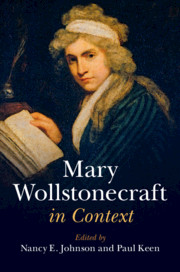Book contents
- Mary Wollstonecraft in Context
- Mary Wollstonecraft in Context
- Copyright page
- Contents
- Illustrations
- Notes on Contributors
- Preface
- Frontispiece
- Chronology
- Part I Life and Works
- Chapter 1 Biography
- Chapter 2 Correspondence
- Chapter 3 Family
- Chapter 4 Joseph Johnson
- Part II Critical Fortunes
- Part III Historical and Cultural Contexts
- Suggested Further Reading
- Index
Chapter 3 - Family
from Part I - Life and Works
Published online by Cambridge University Press: 16 January 2020
- Mary Wollstonecraft in Context
- Mary Wollstonecraft in Context
- Copyright page
- Contents
- Illustrations
- Notes on Contributors
- Preface
- Frontispiece
- Chronology
- Part I Life and Works
- Chapter 1 Biography
- Chapter 2 Correspondence
- Chapter 3 Family
- Chapter 4 Joseph Johnson
- Part II Critical Fortunes
- Part III Historical and Cultural Contexts
- Suggested Further Reading
- Index
Summary
Affirming the presence of mind in so-called affairs of the heart is a signal Wollstonecraft achievement. The conviction emerges out of her intense experiences of the shaping realities of family life. The range of familial settings in which Mary Wollstonecraft lived play a defining role in her reflections on what it means to be born into a particular family and how this beginning affects what follows. The topic informs her life, writing career, reputation, and legacy for a number of interconnected reasons. Wollstonecraft comes of age in an era when familial roles and their connection to civic duties and the rights of men and women are being hotly contested. The contestation is sharpened by debates about the revolution occurring in France, but is not synonymous with it. Wollstonecraft enters an unusually wide range of familial arrangements that heighten her perspectives on the desirability of social and domestic reform. They include the households she resides in as a child with her biological parents and siblings, aristocratic households where she works as a lady’s companion and governess, residences in Europe as a single woman and then single mother, and households she occupies as the lover and then wife of William Godwin along with daughter Fanny Imlay and, for a few days, baby Mary Godwin. In addition, Wollstonecraft is a sex radical in her practice and occasionally in her writings. Her legacy is governed by changing estimations of feminism, egalitarian family roles, sexual liberation, and intersectional identity politics. It is also animated by glaring inconsistencies in what she says, writes, and does as a family member and how these divergences continue even today to shape the contours of family life.
- Type
- Chapter
- Information
- Mary Wollstonecraft in Context , pp. 21 - 28Publisher: Cambridge University PressPrint publication year: 2020
- 3
- Cited by

